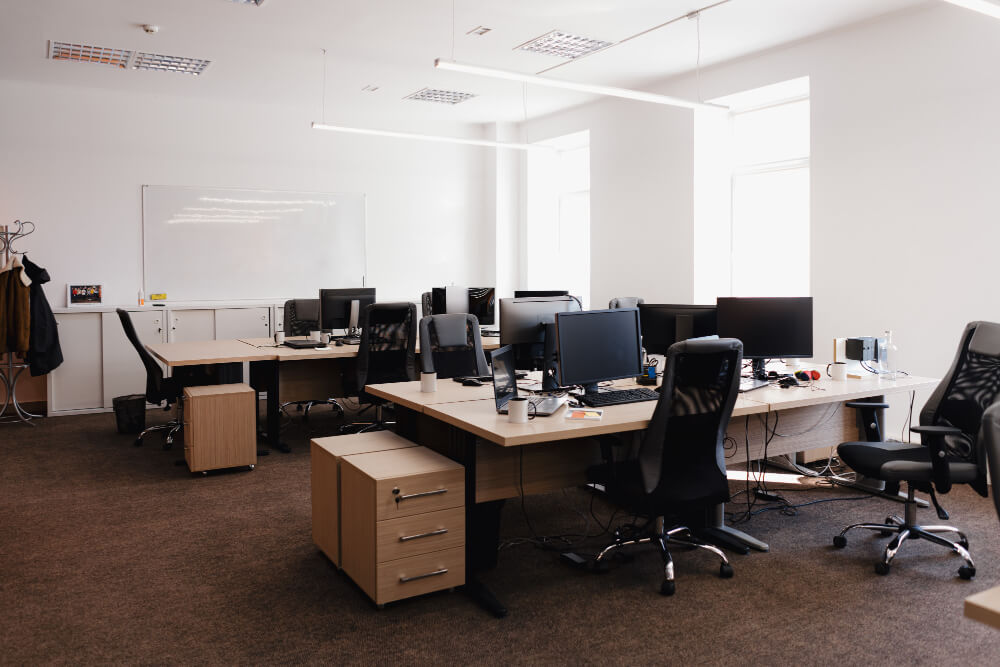Table Of Contents
The Subtle Strain: Why Layout Isn’t Just a Productivity Issue
In manufacturing, assembly, and warehouse operations, the focus often falls on speed, accuracy, and output. Yet behind every efficient process is a worker moving, lifting, reaching, and adjusting, sometimes in ways that strain the body.
When layouts are not intentionally designed with the worker’s comfort and safety in mind, the effects might not appear immediately, but they build over time.
Most ergonomic problems do not begin with a single, dramatic incident. Instead, they start subtly, such as a wrist extended too far, a shoulder rotated awkwardly, or a back bending repeatedly throughout the day.
These small movements can go unnoticed on the floor but gradually lead to discomfort that eventually turns into injury. Office layout productivity is actually a thing, and it can impact how people work.
The risks slowly develop and it is often overlooked. Workers might not talk about the minor inconveniences until they become persistent. However, it is the duty of the supervisors to take a look into things from time to time.

What Is An Office Layout?
The office layout is all about how the workplace is designed and structured, where everything is placed. How the meeting rooms are designed, how individual desks are spaced, how the break areas are organized, everything falls under this umbrella.
The working environment influences the state of mind and shapes the creativity level as well. Moreover, it directly affects focus abilities, creativity levels, and interpersonal relationships.
Office Layout Productivity: How Does It Impact?
Office layout productivity is actually a thing. Productivity has a strong connection with how things are designed. You need to put your mind to it. The more you think creatively to increase their productivity, the better it will impact your organization.
1. Enhances communication & Collaboration
Communication and collaboration are a huge part of a successful business. It is important that all team members stay on the same page. If you make a proper strategy to design the workplace ot can get you both.
For example, providing meeting rooms and break areas where cross-functional teams can engage will spark innovative ideas. Moreover, integrated technology in these places will make sure that information is passed on smoothly and communication is transparent across hierarchies.
When people move out of their restricted cubicles and reach for an open-plan layout, it encourages spontaneous conversations and sudden unplanned brainstorm sessions to make sure you have strong relationships and share ideas.
2. Supports Employee Satisfaction & Well-Being
It might come as a surprise, but architectural planning can affect staff wellness dramatically at the workplace. Natural light reduces eye strain and also lifts mood.
Optimally adjusted workspaces with required amenities make work feel more comfortable and reduce the chance of any illness.
Moreover, keeping a place where employees can relax and unwind contributes to their mental well-being as well. A quiet place to sit a while or read a book can help employees relax.
If you get the code to keep all your employees happy, you will automatically have a more productive workplace.
3. Maximizes Space Utilization
Office layout productivity is not just about promoting well-being or increasing productivity. It is also necessary for maximum space utilization. Every corner costs money, so you need to make sure that you use every corner effectively.
Moreover, you will need the right balance between relaxation corners, meeting areas, workstations, and storage spaces. It could be challenging to attain everything together, but this will help with the operational needs.
It is not just about productivity, and not just about the workspace as well. Basically, it is a mixture of both. You have to ensure that everything is taken care of.
Things To Consider While Planning
The world of office layouts might be very complicated. However, there are several factors that you have to consider.
1. Shape & Size
The first thing that you have to keep in mind is the size and shape of the office. Every inch of the office has potential for productivity. Think how much space they will need to work comfortably. Moreover, you will have to evaluate individual tasks to alot space.
2. Number Of Employees
Keep a track of the number of employees there are in the organization. Do you have a large team or a small one? It is different in both cases and needs different office layouts. The number of employees decide desk allotment as well as private secions and communal spaces.
3. Type Of Work Performed
Also, you will have to understand the nature of business operations that happens in the workplace. The kind of work that is regularly done. If it needs intense concentration, then what kind of design will be suitable? You need to make your call depending on these factors.
4. Privacy Requirements
Every organizations has their unique privacy requirements. If there is a place where sensitive information is discussed then you have to ensure a layout that contributes to privacy.
5. Budget
Budget is one of the most understated, but it plays a major role in the decision-making process. The cost can depend on investing in new furniture, hiring professionals, and choosing what kind of workplace you want.
Moving From Reactive To Preventive Thinking
Addressing these concerns requires adopting a preventive mindset instead of waiting for injuries to occur. It begins with observing how employees move in their work areas and designing layouts that support natural, safe movements.
One proven approach is to keep materials and tools within the “ergonomic zone,” which is between shoulder and knee height. This minimizes awkward bending, overreaching, or twisting.
Take sanitary belt conveyors, for example. Beyond moving items from one place to another, they can be positioned to deliver parts directly into ergonomic zones, reducing the number of high-risk motions and allowing employees to work more efficiently and comfortably.
Ergonomics As A Driver Of Performance
It can be tempting to view ergonomics as a secondary consideration in office layout productivity. In reality, it is a critical factor that influences safety, employee well-being, and overall performance.
Even small adjustments, such as raising a container, rearranging a tool rack, or adding adjustable work surfaces, can help distribute workload evenly and prevent fatigue from concentrating in specific muscle groups.
Layouts that work in harmony with the human body not only reduce the likelihood of injury but also improve morale, productivity, and retention.














